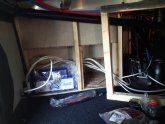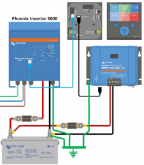I have 2 BB batteries. moving from up front storage area in 5th wheel (stock battery location), moving under steps next to the PD converter.
In stock location the battery negative was grounded to frame.
The plan is to keep the existing wire run to the front (with a few tweaks) and using the 2nd positive and negative on the PD direct to the new batteries. Only ground now is the bare copper attached to the converter.
So is it okay to just run a positive and negative to converter (with a shut off on positive) and call it a day?
Then comes the inverter. It has a grounding wire that I need to attach somewhere. can I ground that using the bare copper wire going from the converter and fuse panel to frame.....
Pic of where I will be putting batteries. one just laying to get idea and measurements to fit.
In stock location the battery negative was grounded to frame.
The plan is to keep the existing wire run to the front (with a few tweaks) and using the 2nd positive and negative on the PD direct to the new batteries. Only ground now is the bare copper attached to the converter.
So is it okay to just run a positive and negative to converter (with a shut off on positive) and call it a day?
Then comes the inverter. It has a grounding wire that I need to attach somewhere. can I ground that using the bare copper wire going from the converter and fuse panel to frame.....
Pic of where I will be putting batteries. one just laying to get idea and measurements to fit.






